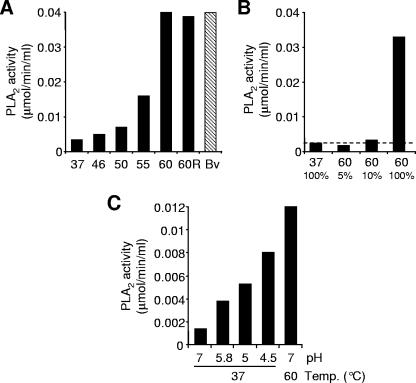FIG. 5.
PLA2 activity of heat- and low-pH-treated B19 native capsids. (A) PLA2 activity of B19 capsids (1.8 μg) was measured following exposure to increasing temperatures for 3 min and rapidly cooled on ice. The bar labeled “60R” represents capsids treated at 60°C for 3 min, slowly cooled to 37°C, and further incubated at 37°C for 1 h. Bv, bee venom (1 ng). (B) Quantification of the basal PLA2 activity of native untreated B19 capsids. Viral capsids (1.2 μg) were treated for 3 min at 60°C to achieve maximal PLA2 activity. Following the heat treatment, the viral suspension was diluted 10- and 20-fold and the PLA2 activity was measured and compared to that of untreated capsids. (C) PLA2 activity of low-pH-treated B19 capsids. After the treatment, the pH of the viral suspension was neutralized by dilution in assay buffer (Cayman Chemical, Ann Arbor, MI). A final amount of 0.5 μg of B19 capsids was used to measure the PLA2 activity.

